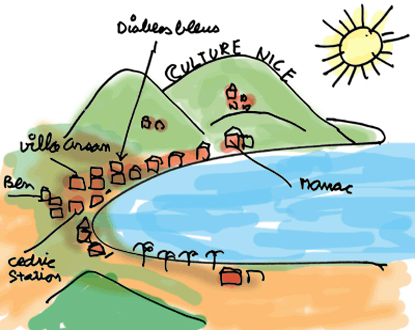The French Riviera, particularly Nice, boasts an exceptionally rich and diverse cultural heritage, a result of its geographical location and history. Its contributions in several cultural disciplines such as music, cinema, literature, visual arts, and others grant it an important and specific status.
In particular, 20th-century art can be considered as one of the region’s most remarkable specialties. Artists like Renoir, Picasso, Chagall, Léger, Matisse, and Bonnard are regularly honored in the museums and foundations of the French Riviera that they all loved and inhabited. The “École de Nice” continued this tradition with artists like Klein, César, Arman, Alocco, Ben, and others, up to the present day where numerous artists living and working in Nice and its region are regularly exhibited by galleries, foundations, and many museums.
However, the French Riviera as a whole suffers from a rather mixed cultural image. As noted by Jean-Louis Prat, who successfully directed the Maeght Foundation—considered one of the best venues dedicated to contemporary art in France—and is an expert in the field, “the French Riviera may be dying from having been too spoiled.
Without a completely renewed cultural vocation, it will suffer tremendously. A mistake has certainly been made by creating too many venues (14 museums in Nice…) of varying quality. Some of these venues lack both the resources and the leaders capable of running them to a sufficient level of quality.”
The city of Nice suffers from this situation, despite the significant portion of its budget it allocates to culture (about 15%, of which nearly half is used for the opera and the philharmonic orchestra).
There is still a lack of coordination and an overall cultural policy, a great momentum that would give the city and, consequently, the French Riviera, a new boost.
At a time when European cities are increasingly competing fiercely, culture becomes a major issue for each of them. We can indeed observe everywhere the exponential multiplication of exhibitions, shows, festivals, and cultural events…
On the French Riviera, given the weakness of the industrial fabric apart from tourism and real estate, culture is more than ever a particularly sensitive and important issue.
Fortunately, Nice retains its charm and is not without assets.
Some MAMAC exhibitions and some operas are of high caliber. “Art in the City” punctuates the route of the first tram line with works by contemporary artists, which ends with a remarkable architectural achievement, a “multimodal station” that earned its architect Marc Barani a silver t-square, the highest award for an architect in France.
Let’s also mention interesting and dynamic initiatives like the association Botox(s).
The Théâtre de la Photographie et de l’Image presents high-level exhibitions. It is an original institution in France outside of Paris, entirely dedicated to photography.
So, in Nice, will culture finally be considered as a major issue that underpins a large part of the activity of our developed societies? Or will communication prevail, and should we fear a culturally saturated environment?
by Christian Depardieu, director of Performarts


